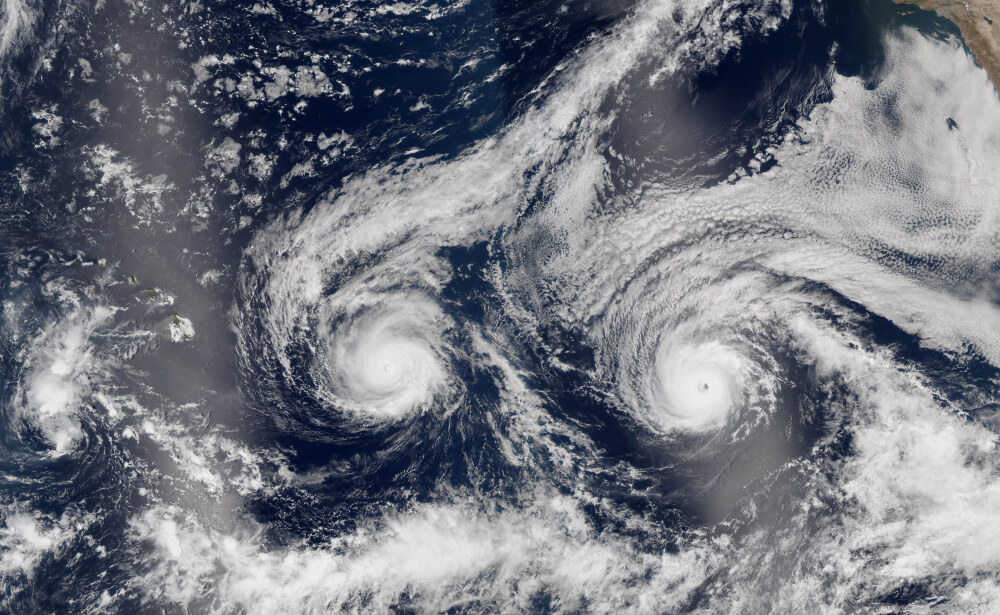Hurricane season continues: some storms threaten the US
Even after Hurricane Sally is gone, meteorologists are busy observing four other cyclones in the Atlantic Ocean. Writes about it Sun sentinel.

Photo: Shutterstock
Among them are the powerful Hurricane Teddy (category 4) and the tropical depression 22, which formed on Thursday evening, September 17, in the southwestern Gulf of Mexico, which could be a problem for Texas.
As of Friday morning, September 18, the depression was 245 miles (394 km) east of Tampico, Mexico. Its maximum wind speed reached 35 miles (56 km) per hour, and it moved northeast at a speed of 6 miles (9,6 km) per hour. According to forecasts, this storm will approach Texas most likely on Sunday and then it will be able to approach the strength of the hurricane.
If depression becomes the next named storm, it will be Wilfred. It will be followed by names from the Greek alphabet: Alpha, Beta and Gamma. This only happened once, during the record-breaking 2005 hurricane season, which spawned Katrina and Wilma.
Hurricane Teddy is expected to approach Bermuda as a hurricane this weekend, increasing the risk of high winds, storm surges and heavy rains, the National Hurricane Center said.
By topic: The first victims and the alligator in the yard: the consequences of hurricane Sally in the USA
Strong waves are expected to hit regions of the southeastern United States in the next few days.
On Friday morning, September 18, Teddy was approximately 550 miles (885 km) northeast of the Northern Leeward Islands, moving northwest over the open Atlantic at 12 miles (19,3 km) per hour with maximum wind resistance 130 miles (209 km) per hour.
Teddy is a severe storm with hurricane force winds extending 60 miles (96,5 km) from its center, and its tropical storm force winds stretching out to 230 miles (370 km).
As a result, huge waves will reach the Lesser Antilles and the northeastern coast of South America, and by the weekend may spread west to the Greater Antilles, Bahamas, Bermuda and the east coast of the United States.

Screenshot: nhc
There are currently no warnings, but in the five-day forecast of the hurricane center, it goes straight to Bermuda, which has just hit a direct hit from Hurricane Paulette.
The former Vicki Tropical Depression disappeared about 1050 miles (1 km) northwest of the Cape Verde Islands on Thursday afternoon September 686.
Forecasters from the National Hurricane Center are monitoring two other cyclones in the distant Atlantic.
A tropical wave located a few hundred miles off the west coast of Africa has a 50% chance of developing into a storm as it travels west across the Tropical Far East. A tropical depression is expected this week.
And over the far north-east of the Atlantic Ocean, a few hundred miles northeast of the Azores, a non-tropical low-pressure zone formed. He is predicted to have a 30% chance of development. It is expected to reach Portugal on Friday 18 September.
Sally's remains were over South Carolina on the morning of September 18th. The NHC said post-tropical depression is still causing heavy rainfall and may trigger tornadoes. Flood observations were active in parts of the Carolina and southeastern Virginia.
The National Weather Service reported that parts of Georgia can receive up to a foot (30 cm) of rain.
On the subject: Record season: US meteorologists are short of names for 2020 hurricanes
Forecasters said South Carolina could receive single precipitation up to 10 inches (25,4 cm). On Friday, September 18, flooding is possible in parts of North Carolina and Virginia.
This is the time of year when storms are common in the open Atlantic, especially around the Cape Verde Islands. They grow stronger and stronger as they travel west across the Atlantic Ocean and are historically the most powerful and destructive hurricanes.
Hurricane season runs from June 1 to November 30. To date, there have been eight hurricanes and 20 tropical storms this season.
Laura was the first major hurricane of the season to land in Cameron, Louisiana on August 27 in Category 4. Hannah, Isaias and Marco were Category 1 hurricanes that struck Padre Island, Texas, Ocean Isle Beach. (North Carolina) and at the mouth of the Mississippi River. Nana was raging in Central America.
Experts at Colorado State University suggest that 2020 could be the second busiest season on record, behind 2005 when Katrina and Wilma formed. In August, the federal government released an updated forecast for the season, which expected up to 25 storms - a number of storms the agency has never forecast before.
Read also on ForumDaily:
An abnormal 2020 continues: hurricanes, droughts and floods are yet to come
Hurricane protection: will insurance cover disaster damage
Fires and hurricanes: how to prepare for an emergency evacuation
'Extremely Active': Meteorologists Release New Hurricane Season Forecast
Why tornadoes often occur after a hurricane lands on land
Subscribe to ForumDaily on Google NewsDo you want more important and interesting news about life in the USA and immigration to America? — support us donate! Also subscribe to our page Facebook. Select the “Priority in display” option and read us first. Also, don't forget to subscribe to our РєР ° РЅР ° Р »РІ Telegram and Instagram- there is a lot of interesting things there. And join thousands of readers ForumDaily New York — there you will find a lot of interesting and positive information about life in the metropolis.











